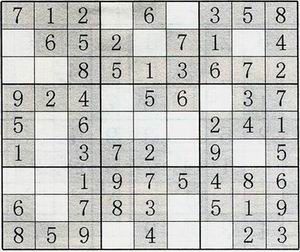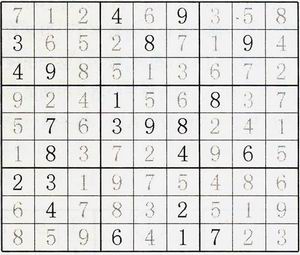|
Problem Description
自从2006年3月10日至11日的首届数独世界锦标赛以后,数独这项游戏越来越受到人们的喜爱和重视。
据说,在2008北京奥运会上,会将数独列为一个单独的项目进行比赛,冠军将有可能获得的一份巨大的奖品———HDU免费七日游外加lcy亲笔签名以及同hdu acm team合影留念的机会。 所以全球人民前仆后继,为了奖品日夜训练茶饭不思。当然也包括初学者linle,不过他太笨了又没有多少耐性,只能做做最最基本的数独题,不过他还是想得到那些奖品,你能帮帮他吗?你只要把答案告诉他就可以,不用教他是怎么做的。 数 独游戏的规则是这样的:在一个9x9的方格中,你需要把数字1-9填写到空格当中,并且使方格的每一行和每一列中都包含1-9这九个数字。同时还要保证, 空格中用粗线划分成9个3x3的方格也同时包含1-9这九个数字。比如有这样一个题,大家可以仔细观察一下,在这里面每行、每列,以及每个3x3的方格都 包含1-9这九个数字。 例题:  答案:  |
|
Input
本题包含多组测试,每组之间由一个空行隔开。每组测试会给你一个 9*9 的矩阵,同一行相邻的两个元素用一个空格分开。其中1-9代表该位置的已经填好的数,问号(?)表示需要你填的数。
|
|
Output
对于每组测试,请输出它的解,同一行相邻的两个数用一个空格分开。两组解之间要一个空行。 对于每组测试数据保证它有且只有一个解。 |
|
Sample Input
7 1 2 ? 6 ? 3 5 8 ? 6 5 2 ? 7 1 ? 4 ? ? 8 5 1 3 6 7 2 9 2 4 ? 5 6 ? 3 7 5 ? 6 ? ? ? 2 4 1 1 ? 3 7 2 ? 9 ? 5 ? ? 1 9 7 5 4 8 6 6 ? 7 8 3 ? 5 1 9 8 5 9 ? 4 ? ? 2 3 |
|
Sample Output
7 1 2 4 6 9 3 5 8 3 6 5 2 8 7 1 9 4 4 9 8 5 1 3 6 7 2 9 2 4 1 5 6 8 3 7 5 7 6 3 9 8 2 4 1 1 8 3 7 2 4 9 6 5 2 3 1 9 7 5 4 8 6 6 4 7 8 3 2 5 1 9 8 5 9 6 4 1 7 2 3 |
|
Code  View Code View Code
1 #include <stdio.h> 2 #include <string.h> 3 #include <stdlib.h> 4 struct Node 5 { 6 int x; 7 int y; 8 }unknown[100]; //recode the coordinate of '?' 9 char m[10][10]; //map 10 int row[10][10]; //recode if the num 1-9 is traversed in this row 11 int column[10][10];//rocode if the num 1-9 is traversed in this column 12 int grid[10][10]; //recode if the nun 1-9 is traversed in the 3*3 grid 13 int n, flag; //n: the num of '?' flag: if u find it 14 void DFS(int step) 15 { 16 int i, j, sx, sy; 17 if (step == n + 1) 18 { 19 //print and mark flag 20 for (i = 1; i <= 9; i++) 21 { 22 for (j = 1; j < 9 ; j++) 23 printf("%c ", m[i][j]); 24 printf("%c\n", m[i][j]); 25 } 26 flag = 1; 27 } 28 //u can return if flag = 1 29 if (flag == 1) 30 return; 31 //get the coodinate of '?' 32 sx = unknown[step].x; 33 sy = unknown[step].y; 34 for (i = 1; i <= 9; i++) 35 { 36 //if the num is travsed in row or column or grid, u can ingore the number 37 if (row[sx][i] == 1 || column[sy][i] == 1 || grid[(sx - 1) / 3 * 3 + (sy - 1) / 3 + 1][i] == 1) 38 continue; 39 //firstly remark it to 1, then deep search, if u can't get it, u should change it to 0 40 row[sx][i] = 1; 41 column[sy][i] = 1; 42 grid[(sx - 1) / 3 * 3 + (sy - 1) / 3 + 1][i] = 1; 43 m[sx][sy] = i + '0'; 44 DFS(step + 1); 45 row[sx][i] = 0; 46 column[sy][i] = 0; 47 grid[(sx - 1) / 3 * 3 + (sy - 1) / 3 + 1][i] = 0; 48 } 49 } 50 int main() 51 { 52 int i, j; 53 int k = 1; 54 do { 55 //initializing 56 memset(row, 0, sizeof(row)); 57 memset(column, 0, sizeof(column)); 58 memset(grid, 0, sizeof(grid)); 59 n = 0; 60 flag = 0; 61 for (i = 1; i <= 9; i++) 62 { 63 //this method is easier and straightforward 64 scanf("%c %c %c %c %c %c %c %c %c", &m[i][1], &m[i][2], &m[i][3], &m[i][4], &m[i][5], &m[i][6], &m[i][7], &m[i][8], &m[i][9]); 65 getchar(); 66 //pretreatment: get the coodinate of '?' and mark these number to 1 67 for (j = 1; j <= 9; j++) 68 { 69 if (m[i][j] == '?') 70 { 71 n++; 72 unknown[n].x = i; 73 unknown[n].y = j; 74 } 75 else 76 { 77 row[i][m[i][j] - '0'] = 1; 78 column[j][m[i][j] - '0'] = 1; 79 grid[(i - 1) / 3 * 3 + (j - 1) / 3 + 1][m[i][j] - '0'] = 1; 80 } 81 } 82 } 83 //don't forget it, or u will get presentation Error 84 if(k++ > 1) 85 printf("\n"); 86 DFS(1); 87 } while(getchar() == '\n'); //I still confuse for this 88 return 0; 89 } |
|
Idea This is normal DFS, but u should translate it. The difficult point is that limited condition, I use three array to mark if the num is traversed. Besides, u should care about the input, I find that when I use do... while, I accepted, I still confuse about it.
|
|
Recommend
LL
|
